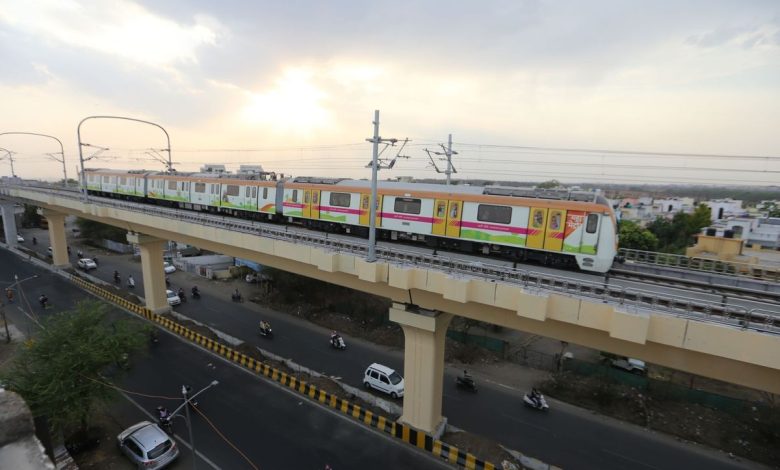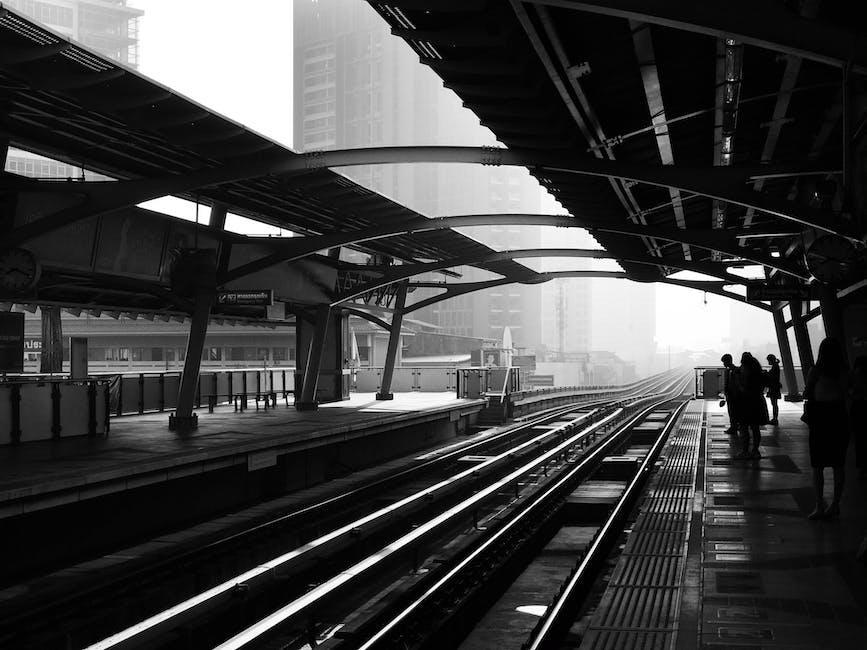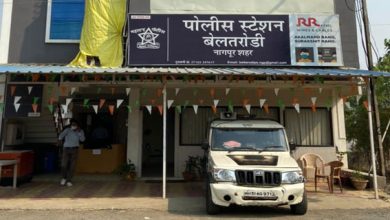Nagpur Metro Route: Revolutionizing Speed and Convenience

-
Table of Contents
- Introduction
- Exploring the Expansive Nagpur Metro Route: A Comprehensive Guide
- The Impact of Nagpur Metro Route on Commuting and Connectivity
- Unveiling the Architectural Marvels Along the Nagpur Metro Route
- Nagpur Metro Route: A Game-Changer for Sustainable Urban Development
- Discovering the Historical Significance Along the Nagpur Metro Route
- Nagpur Metro Route: Enhancing Accessibility and Livability in the City
- Future Prospects and Expansion Plans of the Nagpur Metro Route
“Nagpur Metro: Connecting the City, Empowering the Future.”
Introduction
Nagpur Metro is a rapid transit system serving the city of Nagpur in the state of Maharashtra, India. The metro network consists of two lines, namely the Orange Line and Aqua Line, covering a total distance of approximately 38 kilometers. The Nagpur Metro aims to provide a convenient and efficient mode of transportation for the residents and visitors of Nagpur, connecting various key areas of the city. Nagpur Metro Timing
The Nagpur Metro Timing refers to the schedule and operational hours of the Nagpur Metro, a rapid transit system serving the city of Nagpur in Maharashtra, India. To provide efficient and convenient transportation to the residents and visitors of Nagpur, the metro system operates on a predetermined timetable that outlines the exact timings for the commencement and conclusion of its services.
The Nagpur Metro Timing ensures that commuters can plan their journeys and rely on the metro’s punctuality. The metro services are available on all days of the week, including weekends and public holidays, thereby catering to the diverse needs of the public around the clock.
The metro system typically starts its operations early in the morning, allowing early risers and those with time-sensitive commitments to conveniently commute to their desired destinations. The exact time of the first train departure varies depending on the metro line and the specific station, with each station having its own designated time for the initiation of services.
Throughout the day, the Nagpur Metro operates at regular intervals, ensuring that passengers do not have to wait for extended periods. The frequency of the metro trains is meticulously planned to accommodate the passenger load and demand, especially during peak hours when the number of commuters is higher. This helps reduce overcrowding and ensures a comfortable and seamless travel experience for all.
The Nagpur Metro Timing also takes into consideration the needs of late-night travelers, as the last train departure time is scheduled to accommodate those who require transportation during later hours. This allows individuals attending events, working late shifts, or simply enjoying the city’s nightlife to rely on the metro system for their safe and convenient journey back home.
The operational timings of the Nagpur Metro system are subject to periodic updates, taking into account factors such as changing passenger demand, maintenance requirements, and any unforeseen circumstances. Therefore, commuters should stay updated with the latest information regarding the metro timings through official sources, such as the Nagpur Metro website, announcements at the stations, or dedicated mobile applications.
Overall, the Nagpur Metro Timing plays a crucial role in facilitating smooth and hassle-free commuting for the people of Nagpur, contributing to the city’s development and enhancing its public transportation infrastructure.
Exploring the Expansive Nagpur Metro Route & Nagpur Metro Timing: A Comprehensive Guide
Nagpur, a city located in the heart of India, is known for its rich history, vibrant culture, and bustling streets. In recent years, it has also gained recognition for its modern infrastructure, particularly the Nagpur Metro. The Nagpur Metro is a rapid transit system that aims to provide efficient and convenient transportation to the city’s residents and visitors. With its expansive route, the Nagpur Metro connects various key areas, making it easier for people to travel across the city.
The Nagpur metro route covers a distance of approximately 38 kilometers, with two operational lines: the Orange Line and the Aqua Line. The Orange Line, also known as Line 1, stretches from Sitabuldi to Khapri, covering a distance of 22.9 kilometers. This line has a total of 22 stations, including major landmarks such as Nagpur Railway Station, Zero Mile Stone, and the International Airport. The Aqua Line, or Line 2, runs from Lokmanya Nagar to Prajapati Nagar, covering a distance of 15.7 kilometers. This line has 19 stations, connecting important areas like Ajni Square, Congress Nagar, and Automotive Square.
One of the key advantages of the Nagpur Metro route is its seamless connectivity. The metro system is designed to integrate with other modes of transportation, such as buses and railways, making it easier for commuters to switch between different modes of travel. This integration not only reduces travel time but also provides a more convenient and comfortable experience for passengers. Additionally, the Nagpur Metro route is strategically planned to cover areas with high population density, commercial centers, educational institutions, and healthcare facilities, ensuring that it caters to the needs of a diverse range of commuters.
The Nagpur Metro route is not only about convenience; it also focuses on sustainability and environmental conservation. The metro system is powered by solar energy, with solar panels installed on the rooftops of stations and depots. This renewable energy source helps reduce the carbon footprint of the metro system, making it an eco-friendly mode of transportation. Furthermore, the Nagpur Metro route encourages the use of bicycles by providing dedicated parking spaces and rental services at various stations. This initiative promotes a healthier and greener lifestyle while reducing traffic congestion on the city’s roads.
Safety is another crucial aspect of the Nagpur Metro route. The metro system is equipped with state-of-the-art technology, including CCTV cameras, emergency alarms, and fire safety measures, ensuring the well-being of passengers at all times. Trained security personnel are also present at stations and on trains to maintain a safe and secure environment. These measures instill confidence in commuters, making the Nagpur Metro route a reliable and trustworthy mode of transportation.
In conclusion, the Nagpur Metro route is a comprehensive and well-planned network that connects various parts of the city. With its seamless connectivity, focus on sustainability, and commitment to safety, the metro system offers a convenient, eco-friendly, and secure mode of transportation for the residents and visitors of Nagpur. Whether it’s for daily commuting, exploring the city’s attractions, or simply enjoying a hassle-free journey, the Nagpur Metro route is undoubtedly a game-changer in the transportation landscape of the city. So hop on board and experience the convenience and comfort of the Nagpur Metro!
The Impact of Nagpur Metro Route on Commuting and Connectivity
The Nagpur Metro Route has had a significant impact on commuting and connectivity in the city. With its efficient and modern infrastructure, the metro has revolutionized the way people travel in Nagpur. The metro route spans across various parts of the city, connecting major residential and commercial areas, making it easier for people to commute to their workplaces, schools, and other important destinations.
One of the key benefits of the Nagpur Metro Route is its ability to reduce travel time. With the metro, people can now reach their destinations much faster than before. This has not only improved productivity but has also reduced the stress and fatigue associated with long hours of travel. The metro has become a preferred mode of transportation for many, as it offers a comfortable and hassle-free journey.
Moreover, the Nagpur Metro Route has also had a positive impact on the environment. By encouraging people to use public transportation, the metro has helped in reducing the number of private vehicles on the road. This, in turn, has led to a decrease in air pollution and traffic congestion. The metro is powered by electricity, making it an eco-friendly alternative to traditional modes of transportation.
The metro route has also played a crucial role in enhancing connectivity in Nagpur. It has connected various parts of the city that were previously inaccessible or poorly connected. This has opened up new opportunities for businesses and has facilitated economic growth in the region. The improved connectivity has also made it easier for people to access healthcare facilities, educational institutions, and other essential services.
Furthermore, the Nagpur Metro Route has had a positive impact on the real estate sector. The areas along the metro route have witnessed a surge in property prices and demand. People are now willing to invest in properties located near metro stations, as it offers convenience and accessibility. This has led to the development of new residential and commercial projects along the metro route, boosting the overall growth of the city.
In addition to its impact on commuting and connectivity, the Nagpur Metro Route has also brought about social and cultural changes in the city. The metro has become a symbol of modernity and progress, instilling a sense of pride among the residents of Nagpur. It has also become a common meeting point for people from different walks of life, fostering social interactions and community bonding.
In conclusion, the Nagpur Metro Route has had a transformative impact on commuting and connectivity in the city. It has not only reduced travel time and improved productivity but has also contributed to a cleaner and greener environment. The metro has enhanced connectivity, opened up new opportunities, and stimulated economic growth. Moreover, it has brought about social and cultural changes, making Nagpur a more vibrant and inclusive city. The Nagpur Metro Route is a testament to the power of modern infrastructure in shaping the future of urban transportation.
Unveiling the Architectural Marvels Along the Nagpur Metro Route
Nagpur, a city located in the heart of India, is known for its rich cultural heritage and historical significance. However, in recent years, it has also gained recognition for its modern infrastructure and architectural marvels. One such marvel is the Nagpur Metro, a rapid transit system that has transformed the way people commute in the city.
The Nagpur Metro route spans across various parts of the city, connecting major landmarks and commercial hubs. As you travel along this route, you will be mesmerized by the architectural brilliance that adorns the metro stations. Each station is a testament to the city’s commitment to blending modernity with its traditional roots.
One of the most striking stations along the Nagpur Metro route is the Sitabuldi Interchange. This station, located in the heart of the city, is a perfect blend of modern design and traditional elements. The station’s facade is adorned with intricate carvings and motifs inspired by Nagpur’s rich cultural heritage. As you step inside, you will be greeted by a spacious and well-lit concourse, adorned with beautiful murals depicting the city’s history.
Moving further along the route, you will come across the Khapri Metro Station. This station stands out for its unique design, inspired by the famous Deekshabhoomi, a Buddhist monument located in Nagpur. The station’s architecture reflects the serenity and tranquility associated with Buddhism, with its clean lines and minimalist design. The use of natural materials like wood and stone further enhances the station’s aesthetic appeal.
Another architectural gem along the Nagpur Metro route is the Airport South Metro Station. This station, as the name suggests, is located near the city’s airport and serves as a gateway to Nagpur for travelers. The station’s design is inspired by the aviation industry, with its sleek and futuristic look. The use of glass and steel gives the station a modern and sophisticated feel, while the spacious interiors provide a comfortable waiting area for passengers.
As you continue your journey along the Nagpur Metro route, you will encounter many more architectural marvels. Each station has its own unique design and character, reflecting the essence of the neighborhood it serves. From the vibrant and colorful interiors of the Lokmanya Nagar Metro Station to the grandeur of the Subhash Nagar Metro Station, every station is a visual treat for passengers.
The Nagpur Metro route not only provides a convenient mode of transportation but also offers a glimpse into the city’s architectural heritage. The stations along the route are not just functional structures but works of art that celebrate Nagpur’s rich cultural past. Whether you are a local resident or a visitor to the city, exploring the Nagpur Metro route is an experience that should not be missed.
In conclusion, the Nagpur Metro route is a treasure trove of architectural marvels. From the Sitabuldi Interchange to the Airport South Metro Station, each station showcases the city’s commitment to blending modernity with its traditional roots. As you travel along this route, take a moment to appreciate the intricate designs and artistic brilliance that adorn these stations. The Nagpur Metro is not just a mode of transportation; it is a journey through the city’s architectural heritage.
Nagpur Metro Route: A Game-Changer for Sustainable Urban Development

Nagpur Metro Route: A Game-Changer for Sustainable Urban Development
The Nagpur Metro Route is set to revolutionize the city’s transportation system and pave the way for sustainable urban development. With its efficient and eco-friendly design, the metro will not only provide a convenient mode of transportation but also contribute to reducing traffic congestion and air pollution.
The metro route covers a distance of 38.215 kilometers, connecting various key areas of the city. It consists of two corridors – the North-South corridor and the East-West corridor. The North-South corridor stretches from Automotive Square to Khapri, while the East-West corridor runs from Prajapati Nagar to Lokmanya Nagar.
One of the major advantages of the Nagpur Metro Route is its integration with other modes of transportation. The metro stations are strategically located near bus stops and railway stations, allowing commuters to seamlessly switch between different modes of transport. This integration not only enhances connectivity but also encourages people to opt for public transportation, reducing the number of private vehicles on the road.
The metro route also prioritizes sustainability and environmental conservation. The trains are powered by electricity, making them a greener alternative to traditional modes of transport. This shift towards clean energy will significantly reduce carbon emissions and contribute to the city’s efforts in combating climate change.
Furthermore, the Nagpur Metro Route incorporates several eco-friendly features. The stations are designed to maximize natural lighting and ventilation, reducing the need for artificial lighting and air conditioning. Additionally, rainwater harvesting systems have been installed to conserve water resources. These sustainable practices not only minimize the metro’s environmental impact but also set an example for other cities to follow.
In terms of convenience, the Nagpur Metro Route offers a host of amenities for commuters. The stations are equipped with modern facilities such as escalators, elevators, and ticket vending machines, ensuring a hassle-free experience for passengers. Moreover, the trains are equipped with state-of-the-art technology, including real-time information displays and automated fare collection systems, making the journey more comfortable and efficient.
The metro route also aims to boost economic growth and development in Nagpur. The improved connectivity will attract businesses and investors, leading to the creation of job opportunities and stimulating economic activity. Additionally, the metro will enhance accessibility to educational institutions, healthcare facilities, and commercial centers, improving the overall quality of life for residents.
The Nagpur Metro Route has been meticulously planned to cater to the city’s present and future needs. The project has undergone extensive research and consultation with experts to ensure its effectiveness and sustainability. The metro route is expected to cater to the growing population and urbanization of Nagpur, providing a reliable and efficient mode of transportation for years to come.
In conclusion, the Nagpur Metro Route is a game-changer for sustainable urban development. With its integration with other modes of transport, eco-friendly design, and focus on convenience and economic growth, the metro will transform the way people travel in Nagpur. It is a step towards a greener and more connected future, setting an example for other cities to follow in their pursuit of sustainable development.
Discovering the Historical Significance Along the Nagpur Metro Route
Nagpur, a city located in the state of Maharashtra, India, is known for its rich historical and cultural heritage. As the city continues to grow and develop, one of the most significant projects that has been undertaken is the construction of the Nagpur Metro. This modern transportation system not only aims to provide a convenient mode of travel for the residents but also offers a unique opportunity to discover the historical significance along its route.
The Nagpur Metro route covers a distance of approximately 38 kilometers, connecting various parts of the city. As passengers embark on their journey, they are greeted with a blend of modern infrastructure and glimpses of the city’s past. The metro stations themselves are designed to reflect the cultural heritage of Nagpur, with intricate artwork and architectural elements that pay homage to the city’s history.
One of the notable landmarks along the Nagpur Metro route is the Sitabuldi Fort. Situated in the heart of the city, this fort holds great historical significance. Built during the Bhonsle dynasty, it served as a strategic military outpost. Today, the fort stands as a reminder of Nagpur’s past and offers a panoramic view of the city from its ramparts. As the metro passes by, passengers can catch a glimpse of this majestic structure and appreciate its architectural beauty.
Moving further along the route, the metro passes through the bustling market area of Itwari. This vibrant neighborhood is known for its traditional bazaars and street food stalls. Itwari has been a commercial hub for centuries and continues to attract locals and tourists alike. The metro provides a convenient mode of transportation for those looking to explore this vibrant area and indulge in the local flavors and shopping experiences.
As the metro journey continues, passengers are transported to the tranquil surroundings of the Ambazari Lake. This picturesque lake, surrounded by lush greenery, offers a serene escape from the hustle and bustle of the city. The metro route provides easy access to this natural oasis, allowing passengers to take a break from their daily routine and enjoy the beauty of nature.
Another historical landmark along the Nagpur Metro route is the Deekshabhoomi. This sacred monument holds immense significance for followers of Buddhism as it is the place where Dr. B.R. Ambedkar, the architect of the Indian Constitution, embraced Buddhism along with thousands of his followers. The metro station near Deekshabhoomi serves as a gateway for pilgrims and tourists who wish to pay their respects and learn about the teachings of Buddhism.
The Nagpur Metro route not only connects different parts of the city but also provides a unique opportunity to explore the historical and cultural heritage of Nagpur. From ancient forts to bustling markets and serene lakes, each stop along the route offers a glimpse into the city’s past and present. As passengers travel on the metro, they are not only transported from one destination to another but also embark on a journey through time, discovering the rich history and significance of Nagpur.
Nagpur Metro Route: Enhancing Accessibility and Livability in the City
Nagpur Metro Route: Enhancing Accessibility and Livability in the City
Nagpur, a bustling city in the heart of India, is set to undergo a major transformation with the introduction of the Nagpur Metro. This ambitious project aims to enhance accessibility and livability in the city, providing its residents with a reliable and efficient mode of transportation. The Nagpur Metro route, spanning across various parts of the city, is designed to connect key areas and reduce travel time for commuters.
One of the primary objectives of the Nagpur Metro is to alleviate the traffic congestion that plagues the city. With a population of over 2.5 million people, Nagpur has been grappling with increasing vehicular traffic, leading to long commute times and air pollution. The introduction of the metro system is expected to significantly reduce the number of vehicles on the road, easing traffic congestion and improving air quality.
The Nagpur Metro route is strategically planned to cover major residential, commercial, and educational areas in the city. The first phase of the project, which is already operational, connects Sitabuldi to Khapri, covering a distance of 13.5 kilometers. This stretch serves as a lifeline for many commuters, providing them with a convenient mode of transportation to reach their workplaces, educational institutions, and other important destinations.
The second phase of the Nagpur Metro route is currently under construction and will extend the network further. This phase will connect Automotive Square to Kanhan, covering a distance of 19.7 kilometers. Once completed, this stretch will provide seamless connectivity to areas that were previously difficult to access, opening up new opportunities for residents and businesses alike.
The Nagpur Metro route is designed to be inclusive and accessible to all. The stations are equipped with elevators, escalators, and ramps, making it easier for people with disabilities or mobility issues to use the metro system. Additionally, the metro coaches are air-conditioned, ensuring a comfortable journey for passengers, especially during the scorching summer months.
The introduction of the Nagpur Metro has not only improved accessibility but has also had a positive impact on the livability of the city. With reduced travel time and improved connectivity, residents can now spend more time with their families and engage in recreational activities. The metro system has also spurred economic growth, attracting investments and creating job opportunities in the city.
The Nagpur Metro route is not just a means of transportation; it is a symbol of progress and development for the city. The project has been lauded for its sustainable approach, with a focus on energy efficiency and reduced carbon emissions. The metro system runs on electricity, reducing the city’s dependence on fossil fuels and contributing to a greener environment.
As the Nagpur Metro continues to expand its network, it is poised to revolutionize the way people travel in the city. The project is a testament to the city’s commitment to sustainable development and improving the quality of life for its residents. With its efficient and reliable service, the Nagpur Metro is set to become an integral part of the city’s identity, connecting people and enhancing accessibility for years to come.
Future Prospects and Expansion Plans of the Nagpur Metro Route
The Nagpur Metro, which began operations in March 2019, has quickly become a popular mode of transportation for the residents of Nagpur. With its efficient and reliable service, the metro has significantly reduced travel time and congestion on the city’s roads. However, the current metro route is just the beginning of a much larger plan for the expansion of the Nagpur Metro.
The Nagpur Metro currently operates on a 19.7-kilometer stretch, connecting the Sitabuldi Interchange to Khapri. This route covers important areas of the city, including the airport, railway station, and major commercial hubs. The metro has proven to be a game-changer for commuters, providing them with a comfortable and convenient mode of transport.
Looking ahead, the Nagpur Metro has ambitious plans for expansion. The Maharashtra Metro Rail Corporation Limited (Maha-Metro), the agency responsible for the development and operation of the metro, has proposed two additional routes to further enhance connectivity in the city.
The first proposed route is the North-South Corridor, which will connect Automotive Square to Kanhan. This 19.4-kilometer stretch will pass through key areas such as Kamptee Road, Indora Square, and Mihan. The North-South Corridor will not only provide a seamless commute for residents but also boost economic development in these areas.
The second proposed route is the East-West Corridor, which will connect Prajapati Nagar to Lokmanya Nagar. This 18.6-kilometer stretch will pass through important areas like Wardha Road, Ajni Square, and Congress Nagar. The East-West Corridor will not only improve connectivity but also provide a much-needed relief to the congested roads in these areas.
The expansion plans of the Nagpur Metro also include the development of an Integrated Transport Hub (ITH) at Ajni Square. This hub will serve as a major interchange point, connecting the existing metro route with the proposed North-South and East-West corridors. The ITH will provide seamless connectivity between different modes of transport, including buses, taxis, and auto-rickshaws, making it easier for commuters to switch between different modes of transport.
In addition to the proposed routes and the ITH, the Nagpur Metro also has plans to introduce feeder services to further enhance connectivity. These feeder services will provide last-mile connectivity to areas that are not directly served by the metro. This will ensure that even residents in the outskirts of the city can benefit from the metro’s efficient and reliable service.
The expansion plans of the Nagpur Metro are not only aimed at improving connectivity within the city but also at promoting sustainable transportation. The metro is designed to be eco-friendly, with energy-efficient trains and stations. By encouraging more people to use public transport, the Nagpur Metro aims to reduce the city’s carbon footprint and contribute to a cleaner and greener environment.
In conclusion, the Nagpur Metro has already made a significant impact on the city’s transportation landscape. With its efficient service and comfortable travel experience, it has become the preferred mode of transport for many residents. However, the future prospects and expansion plans of the Nagpur Metro promise even greater connectivity and convenience for the people of Nagpur. With the proposed routes, the Integrated Transport Hub, and feeder services, the Nagpur Metro is set to revolutionize transportation in the city and pave the way for a sustainable future.









